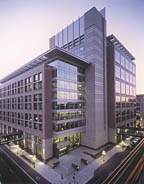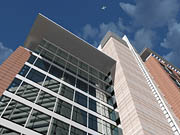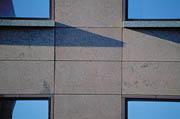

"The goal was to obviously bring Minnesota Life the technological capacity that would bring them into the 21st Century," said Project Designer and Principal Tom DeAngelo, AIA, of Architectural Alliance, the firm who also renovated the lobby of the original headquarters three years prior. "They also wanted to be a good neighbor, and St. Paul has a series of design goals. We wanted to provide a modern, fresh image that would also fit in and represent the dignity and durability of the company for another hundred years."
The stone for the project was supplied by the Cold Spring Granite Co., who supplied a range of granite types. The stone - totaling 146,000 square feet - was used for exterior facades as well as flooring, the reception desk and wall finishes in the main lobby.
Rockville Beige and White granite were selected to complement the palette of the existing headquarters in order to create a campus, according to DeAngelo. In addition, Sunset Red, Cold Spring Black, Royal Red and Imperial Red granites were chosen to mix with the other buildings in the downtown area. The majority of the stone was honed, except for the trim around the exterior windows, which was polished. "We wanted to tie the feeling into the lower town district of St. Paul, which has richer reds," said DeAngelo. "We wanted to introduce a deeper, richer red to get the feeling out of the building."
Jon Jasken, senior project manager from McGough Construction, Inc., the general contractor for the job, expressed similar views to the designer. "The Rockville Beige blends with the building across the street, but they did not want it to be solely Rockville Beige," he said. "The lower town area, which is a blend of older office buildings and warehouses, has a lot of red sandstone. That's where the red tones were brought in."

Creating exterior panels
Granite-clad precast panels were used in the new building, requiring careful coordination between Cold Spring Granite and the precast fabricator, Gage Brothers Concrete Products, Inc. Granite was shipped from Cold Spring Granite to the precast fabricator and then the assembled panels were shipped to the site. According to Jasken, the panels came in vertical pieces -- two floors in height and 5 to 6 feet wide -- or wall panels, extending from the top of the window on one floor to the window sill on the next floor."I think one of the challenges was that this whole method of construction required close coordination between manufacturing of precast panels and delivery of the stone," said DeAngelo. "The idea of putting these granite panels on and actually binding them to the precast in the factory is not entirely new, but it is innovative. It really reduced the production time on the project."
Precast granite panels were stored in trailers in a leased parking lot across the river from downtown St. Paul. The location of the site did not yield the space for the trailers containing the materials during the day. "During the night, they would shuttle trucks in," said Mark Brown, project superintendent from McGough Construction, Inc. "Trailers would bring stone in made for the next area that you would be setting,"
Quality control was also of importance, since the joints of the precast panels needed to be caulked. Wind testing was done as well as mock-ups, according to DeAngelo, to ensure that the panels were secure.
Now completed, the property at 401 Robert was named "Outstanding Downtown Office Building" in the 2001 Awards of Excellence competition, which was sponsored by the Minnesota chapter of the National Association of Industrial Office Properties (NAIOP) in Minneapolis, MN. "The contribution to the environment and the stone is part of that," said DeAngelo. "How it looks, how it feels. We wanted to achieve the richness of depth that the stone can give to a project. We considered colored precast, but the owner chose stone because it exceeded the quality."